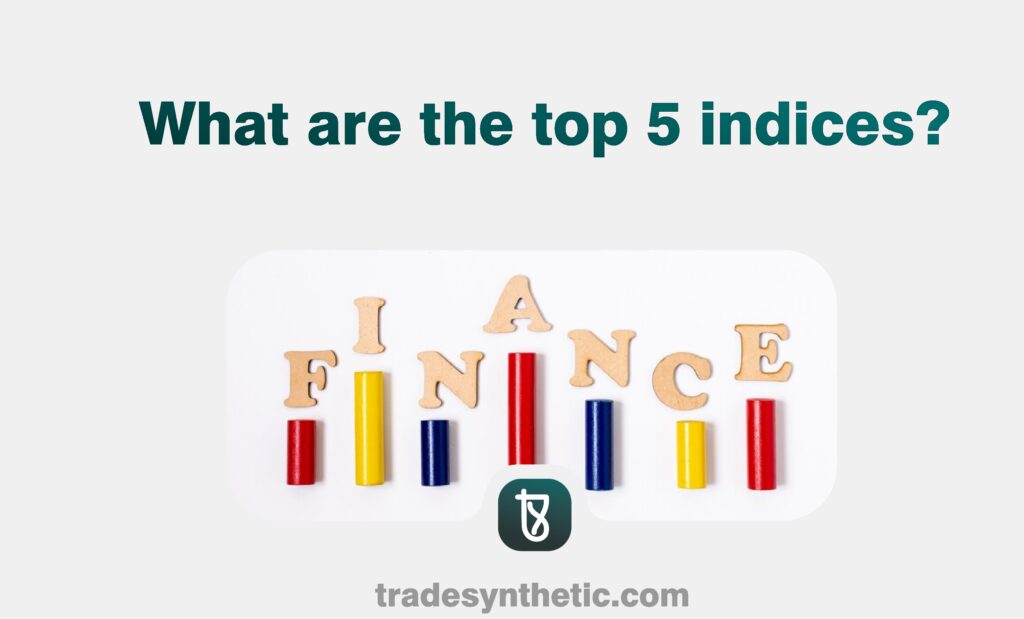In What are the top 5 indices: Stock market indices play a pivotal role in the global economy, serving as benchmarks for assessing the performance of financial markets.
These top 5 indices that are to be mentioned in this article are the most influential benchmarks in the financial world, which have become an integral part of providing investors, analysts, and policymakers with critical insights into market trends and economic performance.
In this article, we’ll delve into the top five stock market indices that dominate the financial world. These indices represent the most critical markets globally, reflecting the health and direction of economies. Let’s explore their unique characteristics, importance, and impact.
Top Indices to Watch for Trading
These indices all have a very definite role to play in mapping varying geographies, sectors, and investment strategies.
1. S&P 500: The Pulse of the U.S. Economy
The S&P 500 forms the backbone of the global financial market, consisting of 500 of the largest publicly traded companies in the United States.
With its broad sector representation and market capitalization weighted structure, this index is indicative of the U.S. economy. It ranges from technology to healthcare, making it a key barometer for investor sentiment.
The S&P 500 has enormous global influence, as it dictates the course of thousands of funds, portfolios, and market decisions. It often dictates the trend in the general financial markets around the world.
2. Dow Jones Industrial Average: A Historic Giant
The Dow, or DJIA, is one of the oldest and most iconic indices, which tracks 30 blue-chip companies in the US. Unlike the S&P 500, the Dow is price weighted, meaning higher-priced stocks have greater influence over the index’s movements.
Its focus on well established, large-cap companies makes it a go-to reference for market trends, even if its narrower scope has drawn criticism for lacking breadth.
Despite this, the Dow remains a powerful symbol of American economic strength, frequently cited in financial media and market analyses.
3. Nasdaq Composite: The Tech Vanguard
The Nasdaq Composite has innovation and technology combined in it. With the heavy concentration of technology, biotechnology, and growth oriented stocks, it depicts a snapshot of the modern economy.
Dominated by technology behemoths like Apple, Tesla, and Alphabet, Nasdaq leads as an indicator for technological advancement and risk appetite for investors.
Its focus on high-growth sectors makes it more volatile than other indices but also positions it as a driver of market innovation. Globally, the Nasdaq sets trends for technology investment and development.
4. FTSE 100: Britain’s Financial Barometer
The FTSE 100, comprising the largest 100 companies listed on the London Stock Exchange, is considered the leading benchmark for the U.K. economy. Many of its constituents have strong international exposure, deriving a substantial part of their revenue outside the United Kingdom.
This global exposure means the FTSE 100 often reflects broader international market dynamics rather than British economic conditions alone. It also displays sensitivity to currency fluctuations especially the British pound-thereby making it very unique in assessing global and regional impacts.
5. Nikkei 225: Japan’s Economic Lens
The Nikkei 225 is Japan’s most famous stock market index, comprising 225 of the largest and most liquid companies on the Tokyo Stock Exchange.
Price-weighted in nature and representative across various industries, it acts as a key indicator for the health of Japan’s economy and its position in the broader Asian market.
As Japan is a big global economy, the moves of Nikkei 225 reflect financial sentiment across the region and act as a bellwether for the market trends of Asia.
Commonalities Among the Top Indices
While each of these indices has unique characteristics, they share some common traits:
1. Market Sentiment Indicators
Stock indices are an indication of investor confidence and economic conditions. Their movements often reflect reactions to news, corporate earnings, or broader economic trends, offering real-time insights into market sentiment.
2. Benchmarks for Investment
Major indices are used as performance benchmarks for portfolios and funds. They are also the basis for passive investment products like ETFs, making them crucial for both active and passive strategies.
3. Global Economic Integration
Most of the indices would have multinational companies, and their performances are coupled with the global economic cycles. If one index, say S&P 500, sees an upward movement, then it influences other indices like Nikkei 225 or FTSE 100, and this shows the interlinkage of markets.
4. Sector Diversity
Covering multiple industries, these indices capture economic trends across sectors, from technology to energy. This diversity makes them reliable indicators of overall market performance.
5. Liquidity and Accessibility
Indices enhance market liquidity and underpin various financial instruments like futures and ETFs. Their visibility attracts both institutional and retail investors.
6. Long-Term Economic Indicators
With time, the indices reflect economic growth and innovation. The historical trend helps in predicting market cycles, while their changing composition hints at the shifting priorities of the globe, such as towards technology and sustainability.
Frequently Asked Questions (FAQs)
What are Indices?
- An index is a statistical measure or indicator of a pool of assets or the market performance in a specific sector. In other words, it is one of those essential tools that show snapshots or the trend and overall performance of the financial markets. Indices are actually often used to benchmark performances in large portfolios, mutual funds, and the economy in general. Popular ones include the S&P 500, representative of the performance level of 500 large listed companies in stock exchanges here in the United States.
In what way does the indices indicate market sentiment?
- Indices move accordingly with investor confidence and perceptions based on such variables as corporate earnings reports, macroeconomic data, and geopolitical events. A high rising index usually indicates optimism, and conversely, a declining index would suggest economic or market distress.
How do I start investing in indices?
- To invest in indices, consider purchasing shares in index-tracking ETFs or mutual funds through a brokerage account. Research the specific index, assess its historical performance, and ensure it aligns with your investment goals.
How do indices impact the global economy?
- Indices impact investor behavior, dictate how capital is allocated, and reflect economic health. As such, policymakers and analysts use them as guideposts on market direction relative to decisions on the economy.










